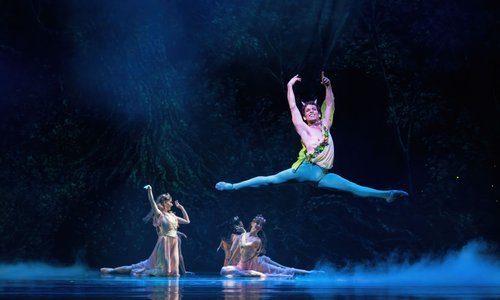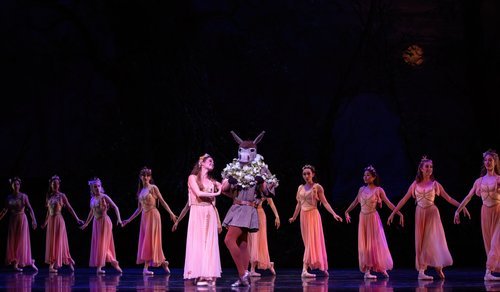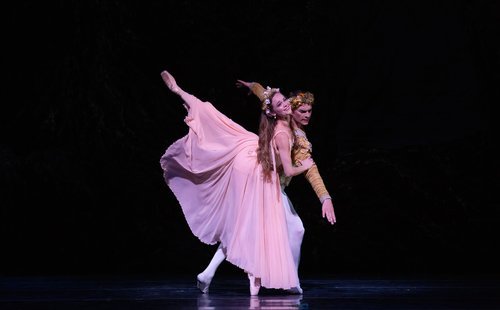A Midsummer Night’s Dream @ Texas Ballet Theater/Winspear Opera House
—Gregory Sullivan Isaacs
From the very first moments, choreographer Ben Stevenson announces that the stiff and mannered previous versions of assembled steps are almost quaint. Texas Ballet Theater gives a lively modern retelling of Shakespeare’s comic romp A Midsummer Night’s Dream, and Stevenson takes Puck’s piquant observation, “Lord, what fools these mortals be!!” as his raison de l’intrigue.
The plot is a little on the complex side, with multiple couples interacting, but Stevenson takes full advantage of the fantastical twists and turns. He remembers that the play is a comedy, too frequently approached as only amusing. Not here. On many occasions, the audience gives it a hearty laugh.
Andre Silva’s spitfire portrayal of Puck illustrates this attitude right from the start. He is a joyful and mischievous spirit who easily tosses caution to the winds. You hardly even notice his astonishing virtuosity, as it’s such a natural outgrowth of his exuberant characterization.
The cast is uniformly excellent, and the company’s bench sufficiently deep to offer different casts throughout the run. But on Friday, we had a special event with the retirement of Carolyn Judson, a 19-year veteran of the company, in a definitive performance of Titania, the fairy queen. She is both playful and dignified at the same time. The encounters between Titania and her slightly less “royal” husband, Oberon (Carl Coomer), lead to some unusual interaction.
Two sets of human lovers offer fodder for the fairies' fun, as the young are wont to do. Hermia (Alexandra Farber) and Lysander (Brett Young), are bubbling examples of overwhelming love. On the other hand, Helena (Samantha Pille) and Demetrius (Kyle Torres-Hiyoshi) offers comic relief with their petulant hostilities.
Shakespeare’s ever-present clowns are reduced to a minimal appearance, but Bottom’s transformation into a jackass, expertly hee-hawed by Riley Moyano, had to remain for other plot purposes.
David Huvel’s sparkly costumes help us tell the magical spirits from the humans—no need for fairy wings. Set designer David Walker’s concept of a magical, vast, and verdant forest with some strikingly painted scenery has great depth. This format allows the stage to be filled yet leaves the dance floor in front free to accommodate a troupe of fairies, demigods, and other love-sick beings, leaving plenty of room to dazzle us with virtuosic dance. However, Shakespeare’s timeless story of life and love (driven by some magical confusion) is never buried by the spectacularly realized choreography.
Unlike some other ballet performances replete with applause breaks for every decently executed tour jeté en tournant or entrelacé, the few moments of allowed audience adulation are worked into the choreography in a natural manner. TBT avoids the too-frequent displays of quadruple whatevers that are tucked in as a gymnastic show.
Mendelssohn’s wondrous score was originally intended as incidental music for a performance of the play, with tunes scattered around to brighten the action as needed.. This means that it’s not through-composed to accommodate a full-length ballet; it must be assembled for the purpose. This delicate task was assigned to the world-famous ballet conductor Jonathan McFee; the actual recording is credited to the London Symphony Orchestra under the batons of André Previn and Claudio Abbado.
An aside: Nothing can compete with a live orchestra for ballet. But at around $60,000 for a few rehearsals and a performance for a per-service orchestra, the number of companies that can afford the luxury is limited. The problem comes in two directions. One is the fact that the recorded music is locked into time and tempo, so the freedom of a dancer in the dramatic moment here or there is limited. In addition, it is played over speakers, frequently too loudly—and the sound is distributed evenly throughout the house, not allowing the instruments to speak separately. However, I will note that the sound for this performance was well-modulated and never called attention to its limitations.
This is a must-see production. Stevenson’s fresh and quirky take on Midsummer makes for a production full of vitality and humor—and the superb dancers of Stevenson’s Texas Ballet Theater gave him the confidence to do it.
And in the end, Puck puts everything right back where it should be. (Of course!)
WHEN & WHERE: Concluding performance @ the Winspear May 8; beginning @ Fort Worth’s Bass Performance Hall on May 20


